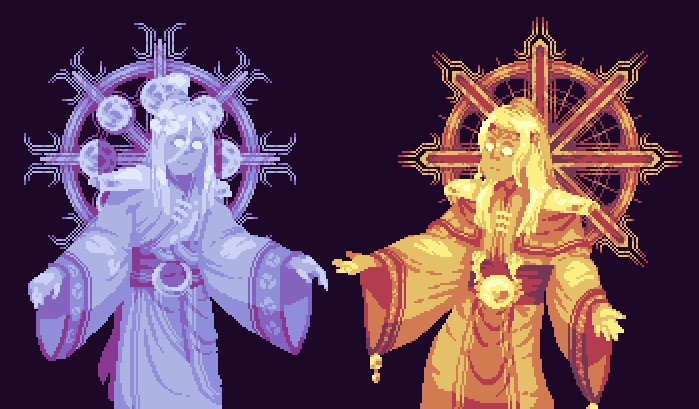Niranni Religion
Religions
Organized Religions
Ansivi and Anevia
The Niranni in the ancient times were said to worship a variety of spirits and held a way of life focused on balance. This religion was less fanatical and pushed for the balance of the Niranni and spirits and emphasis on the ancestors, along with the destruction of those who would seek to upset this balance. It remains common throughout regions like Alsivai and among Monks, however it has fallen out of favor due to the creation of Anevia. Anevia is a development of Ansivi that was brought about later on and became the primary faith on Nirann, being a faith that emphasizes many of the same old values but with more emphasis on deities.SEE ANEVIA ARTICLE
Ilhjisi
Ilhjisi (Eternal Teaching) is a faith centered on the wisdom of the Sianphrs (enlightened teachers). Ilhjisi entails diverse systems of thought, marked by a range of shared concepts that discuss theology and mythology. Ilhjisi is distinguished from other faiths in its region by its worship of Imsura, a single, eternal, omnipresent god. Imsura is viewed as greater energy in the cosmos; some academics believe Imsura and magic are the same thing and that every other deity was corrupted by the 5 Ijhans (demons), which corrupted both mortals and gods with the vices of lust, pride, attachment, ego, and rage. However, many Ilhjisi think that some gods, like Anetos or one of the Sarithra, are still adherents to Imsura's wisdom. The Ithjar articulates the core beliefs of Ilhjisi, which include faith and meditation in the name of the creator, divine unity and equality, self-service, justice for the benefit and prosperity of all, and honest conduct in household life. Ilhjisi originated and evolved during periods of religious persecution. It originated with the first Sianphr, Tsen Irasaj, who arrived during the shattering. Sianphr Tsen Irasaj is claimed to have traveled extensively across Nieden, teaching people about Imsura, who lives in all of his creations and represents eternal truth. He proposed a distinct spiritual, social, and political platform centered on equality, fraternal love, goodness, and virtue. Ilhjisi originated and evolved during periods of religious persecution. It originated with the first Sianphr, Tsen Irasaj, who arrived during the shattering. Sianphr Tsen Irasaj is claimed to have traveled extensively across Nieden, teaching people about Imsura, who lives in all of his creations and represents eternal truth. He proposed a distinct spiritual, social, and political platform centered on equality, fraternal love, goodness, and virtue. When the quarreling Sajwen and Kirrentai followers tugged at the sheet covering his body, they found instead a heap of flowers and so Tsen Irasaj's simple faith would, in course of time, flower into a religion.Animal Cults
Verisma
Verisma, or cult of the wolf, is a warrior cult built around the Ingharan symbol of community and honor. The original animal cult was forced into Anevia, while some resisted and resorted to lycanthropy to fight back and were persecuted heavily. The faith flourished after the shattering due to the powers of lycanthropy being able to help protect, causing the cost of the curse to seem like nothing to the desperate. The Verisma cult found itself controlling areas in Ischurrai, around the lake region of Soranna, in Immestrai, and in the Ingharan valley. The cult was largely wiped out by Atshara but survives in the alps of southern Ischurrai and in Gentarien.Faresma
Faresma, or cult of the fox, is one of the most mischievous cults in Soranna and Ischurrai, being dedicated to the spirit of the fox. The fox cultists worshipped initially the Ingharan symbol of thievery and luck, but the cult devolved into one which practiced shapeshifting and abducting people into the cult. The cults main beliefs are that in the world, one is on their own and they should amass skills to help survive and honor the spirits who gave trickery to man.SEE CULT OF THE FOX ARTICLE



Comments